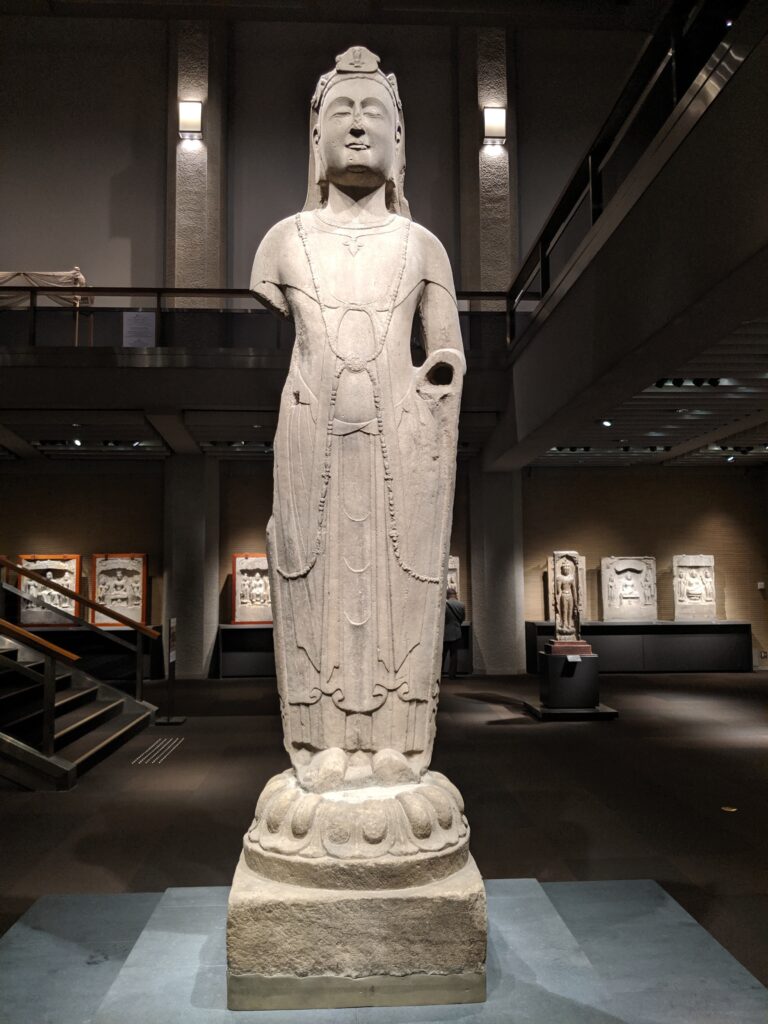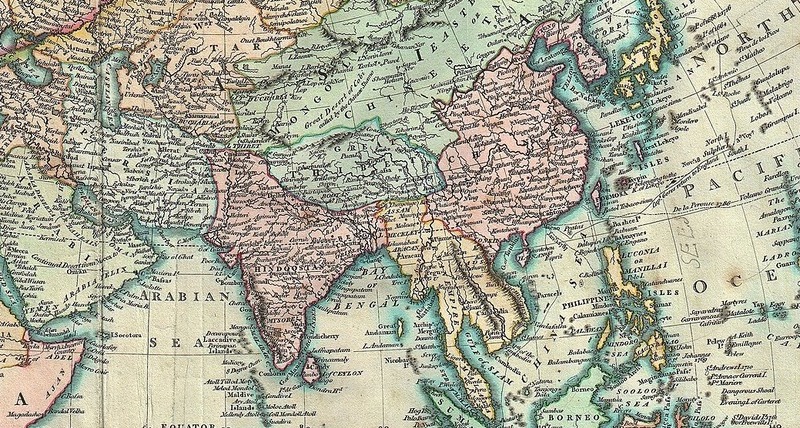It was my first visit to Tokyo. Thanks to a lost-in-translation miscommunication with my scientific colleagues, I found myself with an unexpectedly open daytime schedule. This is how I ended up alone at the Tokyo National Museum one brisk fall weekday morning in 2019, in front of a group of 5th century CE sculptures with what seemed to my uneducated eye to be distinctly Indian aesthetics: upraised palms, multiple arms, lotus symbols. Deeply familiar, yet somehow also strange, like the hazy outlines of barn buildings in an early-morning Midwest fog.
Article continues after advertisement
I had had a similar feeling of familiar unfamiliarity earlier that visit when I stopped by Tokyo’s oldest temple, Senso-ji, built in the seventh century and dedicated to the goddess of mercy, Kannon. The temple was oddly like the temples in India I visited growing up. As if by magic, I seemed to know which hand to use in which sequence at the water ablution basin at its entrance.
My eyes strayed to the small label describing the Buddhist deity in front of me: Avalokitesvara, the bodhisattva of compassion. My Sanskrit is rudimentary at best, but there was no mistaking the language that made up the name, the syllables of my own first name admixed in it, and the suffix -isvara, commonly used for Lord in multiple Indian languages. Soon I would learn that Avalokitesvara was the Sanskrit name for Kannon whose temple I had just visited; that Kannon herself had come from China; that versions of Avalokitesvara were worshipped in Tibetan Buddhism, Korea and Vietnam; that the deity’s Nilakantha Dharani or Great Compassion Mantra, popular in East Asian Buddhism, originally referred to the attributes of Harihara, a composite of the Hindu gods that I grew up worshipping, Vishnu and Shiva. My jet lag made me feel this unexplained web of connections more intensely, and for a while I recall feeling simply staggered.
Immigration, trade, the mixing of peoples and languages and thoughts and ideas and religions—these are not modern phenomena, I am reminded, but simply the shared history of humanity.
I knew, of course, that the Buddha was born an Indian prince, and that Buddhism had traveled east to many lands. I had not imagined, however, that an entire culture could travel in the absence of a leading imperial army, or that such a culture could adapt and syncretize in its new native lands and somehow remain vibrant millennia later. Certainly, there was nothing that I had learned in the history taught in my high school in 1980s India or in my adult reading life that satisfactorily explained the Sanskrit names on the labels in front of me, or how two Hindu gods had somehow transformed into a Japanese goddess.
The thing with jet lag is that it passes, just like the disorientation upon first encountering sunrise after a long-haul flight. That feeling of bewilderment is there the first or second day, and then it isn’t anymore. I went to work later that afternoon and remained engaged in science for the remainder of my visit. The surreal feeling that I had experienced—of a story untold, hidden just out of reach—soon disappeared.
I did not think about Avalokitesvara again until very recently, when I picked up a copy of historian William Dalrymple’s latest book, The Golden Road: How Ancient India Transformed The World. There, to my surprise, was the now-familiar name in the first few pages, centered in one of the early-century CE murals of the Ajanta caves in the Indian heartland; artwork so gorgeous that it ranks, in Dalrymple’s words, as “some of the greatest masterpieces of art produced by mankind in any century…(still) glow(ing) with a brilliant intensity”. The story that followed—a masterpiece of its own, ancient yet thoroughly modern in its themes of globalization, cultural diffusion and soft power, as paradigm-shifting in its Indocentricity as anything I’ve read in popular history—left me just as unsettlingly disoriented as I had been that morning in Japan.
*
The great university of Nalanda in the eastern part of the Indian subcontinent stood nine stories high, hosted thousands of learned monks and students attending lectures in a hundred lecture halls and housed a library then acknowledged to be the greatest repository of knowledge in the world. For a period of seven centuries, scholars here studied logic, Sanskrit grammar, various schools of religion and philosophy related to Hinduism and Buddhism, mathematics, science and medicine. It was here that visiting scholars from China translated the great Sanskrit texts and carried them back over several-thousand-mile dangerous journeys.
From China, Buddhist texts would be recopied and retranslated for audiences in Korea and Japan, eventually syncretizing into Zen Buddhism. It was not only texts that were transmitted—soon to follow were “pioneering merchants, astronomers and astrologers, scientists and mathematicians, doctors and sculptors…holy men, monks and missionaries of several distinct strands of Indic religious thought and devotion.” And it was not only on overland passes that the titular golden road traveled. Indian merchants used the monsoon winds to sail eastward into the long coastlines of the “lands of gold”—what are now Sri Lanka, Myanmar, Malaysia, Thailand, Laos, Vietnam and Cambodia.
 Standing Avalokitesvara, China, dated 585 CE, Tokyo National Museum, Tokyo, Japan (credit: A. A. Khorana).
Standing Avalokitesvara, China, dated 585 CE, Tokyo National Museum, Tokyo, Japan (credit: A. A. Khorana).
Sanskrit and its literary culture rapidly became the lingua franca across much of Asia, in ways still visible today. The national airline of Indonesia, for instance, is called Garuda, after the vehicle of the Hindu god Vishnu. Thailand’s ancient capital is Ayutthaya after Ayodhya, Lord Rama’s capital in the Hindu epic Ramayana. The largest Hindu temple in the world—four times the size of Vatican City—is not in India but Angkor Wat, in Cambodia. The world’s most complex Buddhist structure—the mysterious Borobudur temple in Java, Indonesia—was constructed based on texts brought by two Tantric masters from India.
It isn’t just in ancient buildings and placenames that this history survives. The Pallava-style Brahmi script of south India is the basis for almost every pre-Islamic script in South-east Asia, including Khmer, Javanese, Lao, Thai and Malay. (Astute viewers can spot both this script and Indic culture throughout the third season of The White Lotus, set in Thailand.) As Dalrymple points out, “over half the world’s population today lives in areas where Indian ideas of religion and culture are, or once were, dominant, and where Indian gods ruled the imaginations and the aspirations of men and women.”
Major branches of the golden road also traveled westward. Early Indian traders used the monsoon winds to connect through the Red Sea to Egypt. This route became a veritable gold mine after the tragic deaths of Antony and Cleopatra led to Rome’s takeover of Egypt. For those who think about the Roman Empire once a day, Dalrymple has an astonishing array of new evidence to consider. From pepper and spices to ivory to emeralds to “Indian eunuchs” to the wild animals fighting in the Colosseum—no luxury item, it appears, was off-limits to importation from India, which rapidly became Rome’s greatest trading partner.
At its peak, the scale of this Red Sea trade was so significant that the customs fees raised by Roman officials accounted for one-third of the entire revenue of the Roman Empire. It is no surprise, then, to see Pliny the Elder curmudgeonly complaining about Roman wealth draining into Indian traders’ pockets—“the sink of the world’s most precious metals.” The legacy of this trade is still with us: Tamil and Sanskrit words for sugar, ginger, pepper, cotton and indigo made their way into Latin and eventually to everyday English.
Westward also was how Indian mathematics and science spread, helping create the modern world as we know it. That the concept of zero was developed by Indian thinkers is well-known. Lesser known is the fact that a full thousand years before the Copernican revolution in Europe, twenty-three-year-old Indian mathematician-astronomer Aryabhata had calculated the movements of the planet, knew that the earth rotated on its axis and even the length of the solar year to an accuracy of seven decimal points. A century later, the great scientific genius Brahmagupta further developed the idea of zero into a set of arithmetic rules handling both positive and negative numbers. Translations of Aryabhata’s and Brahmagupta’s works found their way to Baghdad through a Sanskrit-learned family of Buddhist converts to Islam.
This, perhaps, is The Golden Road’s most urgent message for our times: we have always been a deeply globalized, interconnected, mongrel world.
It would be another five hundred years before Indian mathematics, having spread throughout the Islamic world, was serendipitously taught to the young Italian student Fibonacci, who had accompanied his father to a posting in Algeria. It was Fibonacci’s book Liber Abaci that popularized the use of “Arabic numerals” throughout Mediterranean Europe, although Fibonacci himself was quite clear about his sources: “the nine figures of the Indias…a perfect method…(this book written) so that in future the Latin race may not be found lacking this knowledge” Dalrymple makes a highly effective case that it was this “discovery” of Indian mathematics alongside Indian accounting methods by Mediterranean Europe in the early thirteenth century that was responsible for “seeding the commercial revolution that financed the Renaissance and…the economic rise of Europe.” That rise, of course, would fuel the centuries-long colonial pillaging of huge swaths of Asia, including the Indian subcontinent.
*
Voltaire was convinced—mostly, it appears, based on vibes—that India was the birthplace of both religion and civilization. Kant accepted that “all our arts…numbers…chess” came from India. Schopenhauer felt that even Christianity had “Hindu blood in its veins”. Centuries of the “civilizing mission” of colonialism, however, made the historical truth unrecognizable. Dalrymple’s genius lies in not just reinvigorating this idea of what he terms the Indosphere but buttressing his masterful storytelling with mounds of irrefutable evidence (nearly a hundred pages are devoted to footnotes and references).
It seems churlish, then, to point out that stunning as The Golden Road is in its scope, it is still missing—by my amateur calculations—a good additional millennium. Dalrymple chooses the period of Buddhism as his starting point, but centuries of Indic thought—including the Vedas, the Upanishads and Jainism—preceded it. Thomas McEvilley, in his magnum opus The Shape of Ancient Thought, is one of several writers to have pointed to the correspondence between ancient Indian and ancient Greek philosophers. Pre-Socratic texts, “the Ur-fountainhead of the western tradition”, according to McEvilley, were so influenced by Upanishadic and Jain thought that they “might even be called the Indianized or Greco-Indian lineage.” Perhaps a prequel is in order.
*
There is a passage in The Golden Road that I return to over and over. It occurs early in the book, in a description of the gorgeous murals in the Ajanta caves. Dalrymple draws our attention to the “surprisingly international cast of characters…Persians, Parthians, Scythians, Ethiopians, Egyptians…Greeks and Romans, each with distinct clothes, tunics, hairstyles.” Two millennia ago, Dalrymple carefully observes, “Ajanta was evidently built at the center of a deeply globalized world.”
Immigration, trade, the mixing of peoples and languages and thoughts and ideas and religions—these are not modern phenomena, I am reminded, but simply the shared history of humanity. This, perhaps, is The Golden Road’s most urgent message for our times: we have always been a deeply globalized, interconnected, mongrel world. Those who continue to harken for a “pure” past will find it only by fictionalizing it.
